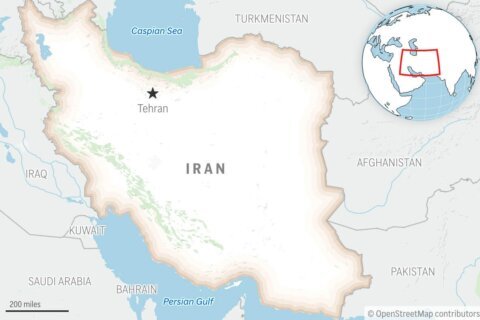WASHINGTON – I’m starting a new tradition on the eve of 2014: Picking what I think is the top space-related story of the year.
Sky Guy Greg Redfern’s Top Space Story for 2013 is: The Chelyabinsk Airburst Event
The 1.2 million citizens of Chelyabinsk, Russia, were going about their daily routines on Feb. 15, 2013 – a very frigid winter day – when at 9:22 a.m. the sky flashed into a brilliance 30 times greater than the Sun.
Security cameras and untold numbers of dash cams recorded the incoming chunk of space rock that silently flew across the sky. The explosion wasn’t heard until minutes later when the city was hit with resounding and destructive shock waves.
It was the greatest airburst event since the 1908 Tunguska event which flattened 80 million trees over 2,000 square kilometers.
Some of the damages from the Chelyabinsk airburst:
- More than 1,600 people injured by flying glass, with injuries including cuts and bruises, retinal and skin burns caused by thermal heat from the fireball explosion, and temporary blindness and deafness;
- 1 million square meters of glass shattered;
- 7,300 buildings damaged, including partial roof and wall collapses on two separate buildings.
The impact was strong enough to rank the event up with hurricanes, earthquakes and tornadoes that have been declared natural disasters by U.S. presidents.
Although there were no fatalities, there well might have been.
The asteroid’s flight path was very shallow relative to the ground – only 18 degrees. So when the 20-meter (62-foot) wide asteroid exploded at an altitude of 30 km (18 miles), the shock waves dissipated over a large area, limiting its destructive power. Had the asteroid come in at a steeper angle, the shock waves would have been much more focused on the ground, people and structures directly beneath, and would have caused much more damage.
The Tunguska airburst was estimated to have the destructive power of 5-15 million tons of TNT while the Chelyabinsk event was more than half a million tons of TNT. Impressive numbers indeed.
The Chelyabinsk event was the most documented airburst and resulting impact event in history. Within hours and days scientists were interviewing witnesses, doing damage assessments and gathering fresh meteorites while pinpointing their locations. The incredible video record of the event – all of which would help recreate the trajectory and orbit of the asteroid – was immediately analyzed.
This analysis led to the identification of asteroid 86039, a 2-km (1.2-mile) wide asteroid Chelyabinsk probably came from. Scientists also determined the asteroid weighed about 12,000 to 13,000 tons and traveled at a speed of 12 miles per second in our atmosphere.
But the real reason why I picked this as my top space story of 2013, is what scientists learned as a result of their investigations and analysis of Chelyabinsk, including a new whole assessment of the threat posed by similar-sized space rocks.
An analysis of 20 years worth of data collected by sensors used to detect nuclear detonations (they can also detect asteroid airbursts) revealed that 60 asteroids the size of Chelyabinsk had occurred. This is far more than had been previously estimated based on telescopic observations and indicates that there are millions of these Near Earth Asteroids (NEAs). The really bad news is that we have discovered less than .01 percent of them.
In plain language, one study’s authors said this means a Chelyabinsk-level event is likely to occur once every 30 years instead of the previously estimated 150 years, and that a Tunguska-level event is likely every few hundred years instead of every few thousand years. This study raised the threat level significantly from previous assessments.
We need better detection of these meter-sized asteroids. We have found a good number of the kilometer sized asteroids – over 90 percent of them – and NASA’s search efforts are finding more asteroids all the time. The 10,000th Near Earth Object (which includes comets in addition to asteroids) was discovered in June of this year.
But space is vast, and often in the past and the present asteroids – some of them rather large – weren’t discovered until after they passed by Earth.
In a best-case post-Chelyabinsk scenario, world governments will recognize impact events as a real global threat, and put more money toward the effort of finding these smaller and hazardous space rocks.
After the 1994 Shoemaker-Levy 9 comet impact on Jupiter, the U.S. Congress mandated NASA to step up efforts to find Earth-threatening objects. But adequate funding has been lacking.
Ideally, we could get to a detection capability that would allow for advance notice of a Chelyabinsk or larger event. Evacuation of the affected area could be done just as it is in hurricane and volcanic events.
But what of larger impact events – those on a scale of Chesapeake Bay Impact Crater 35 million years ago or Chicxulub, which killed the dinosaurs 65 million years ago? We currently have no active defense against such events. Which is why learning about asteroids and comets through manned and unmanned space missions and ongoing research is vital to our long term survival as a species.
Repeat after me – the dinosaurs are dead because they didn’t have a space program.
Chelyabinsk was pivotal in the study of impact events and worthy of my top space story pick for 2013. My fervent hope is that it will lead to more funding for the detection and mitigation of these threats from space. If we accomplish that, that would be a welcome top pick.
Check out a collection of videos from the event here.
Follow my daily blog at myfoxdc.com to keep up with the latest news in astronomy and space exploration. You can e-mail me at skyguyiva@gmail.com.
Follow @WTOP on Twitter.







